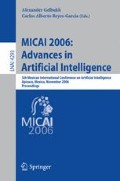Abstract
Iris recognition is a method used to identify people based on the analysis of the eye iris. A typical iris recognition system is composed of four phases: (1) image acquisition and preprocessing, (2) iris localization and extraction, (3) iris features characterization, and (4) comparison and matching. A novel contribution in the step of characterization of iris features is introduced by using a Hammersley’s sampling algorithm and accumulated histograms. Histograms are computed with data coming from sampled sub-images of iris. The optimal number and dimensions of samples is obtained by the simulated annealing algorithm. For the last step, couples of accumulated histograms iris samples are compared and a decision of acceptance is taken based on an experimental threshold. We tested our ideas with UBIRIS database; for clean eye iris databases we got excellent results.
Access this chapter
Tax calculation will be finalised at checkout
Purchases are for personal use only
Preview
Unable to display preview. Download preview PDF.
References
Daugman, J.: How Iris Recognition Works. IEEE Transactions on Circuits and Systems for Video Technology 14(1), 21–30 (2004)
Dobes, M., Machala, L., Tichasvky, P., Pospisil, J.: Human Eye Iris Recognition Using The Mutual Information. Optik (9), 399–404 (2004)
Efros, A., Leung, T.: Texture Synthesis by Non-Parametric Sampling. In: Proceedings of the 7th IEEE International Conference on Computer Vision, September 1999, vol. 2, pp. 1033–1038 (1999)
Hammersley, J.: Monte Carlo Methods for Solving Multivariate Problems. Annals of New York Academy of Science (86), 844–874 (1960)
Huang, Y., Luo, S., Chen, E.: An Efficient Iris Recognition System. In: Proceedings of the First International Conference on Machine Learning and Cybernetics, pp. 450–454 (2002)
Huang, J., Wang, Y., Tan, T., Cui, J.: A New Iris Segmentation Method for Iris Recognition System. In: Proceedings of the 17th International Conference on Pattern Recognition, pp. 554–557 (2004)
Independent Testing of Iris Recognition Technology - Final Report, International Biometric Group (May 2005)
Kirkpatrick, S., Gelatt, C., Vecchi, M.: Optimization by Simulated Annealing. Science 220(4598), 671–680 (1983)
Jain, A., Ross, A., Prabhakar, A.: An Introduction to Biometric Recognition. IEEE Transactions on Circuits and Systems for Video Technology 14(1), 4–20 (2004)
Liang, L., Liu, C., Xu, Y., Guo, B., Shum, H.: Real-time Texture Synthesis by Patch-based Sampling. ACM Transactions on Graphics 20(3), 127–150 (2001)
Ma, L., Wang, Y., Tan, T., Zhang, D.: Personal Identification Based on Iris Texture Analysis. IEEE Transactions on Pattern Analysis and Machine Intelligence 25(12), 1519–1533 (2003)
de Martin-Roche, D., Sanchez-Avila, C., Sanchez-Reillo, R.: Iris ecognition for Biometric Identification using dyadic wavelet transform zero-crossing. In: Proceedings of the IEEE 35th International Conference on Security Technology, pp. 272–277 (2001)
Negin, M., Chmielewski, T., Salganicoff, M., Camus, T., Cahn, U., Venetianer, P., Zhang, G.: An Iris Biometric System for Public and Personal Use. Computer 33(2), 70–75 (2000)
Proenca, H., Alexandre, L.: UBIRIS: A Noisy Iris Image Database. In: Proceedings of the International Conference on Image Analysis and Processing, vol. 1, pp. 970–977 (2005)
Zhu, Y., Tan, T., Wang, Y.: Biometric Personal Identification Based on Iris Patterns. In: Proceedings of the 15th International Conference on Pattern Recognition, pp. 801–804 (2000)
Author information
Authors and Affiliations
Editor information
Editors and Affiliations
Rights and permissions
Copyright information
© 2006 Springer-Verlag Berlin Heidelberg
About this paper
Cite this paper
Castañon, L.E.G., de Oca, S.M., Morales-Menéndez, R. (2006). Optimal Sampling for Feature Extraction in Iris Recognition Systems. In: Gelbukh, A., Reyes-Garcia, C.A. (eds) MICAI 2006: Advances in Artificial Intelligence. MICAI 2006. Lecture Notes in Computer Science(), vol 4293. Springer, Berlin, Heidelberg. https://doi.org/10.1007/11925231_77
Download citation
DOI: https://doi.org/10.1007/11925231_77
Publisher Name: Springer, Berlin, Heidelberg
Print ISBN: 978-3-540-49026-5
Online ISBN: 978-3-540-49058-6
eBook Packages: Computer ScienceComputer Science (R0)

